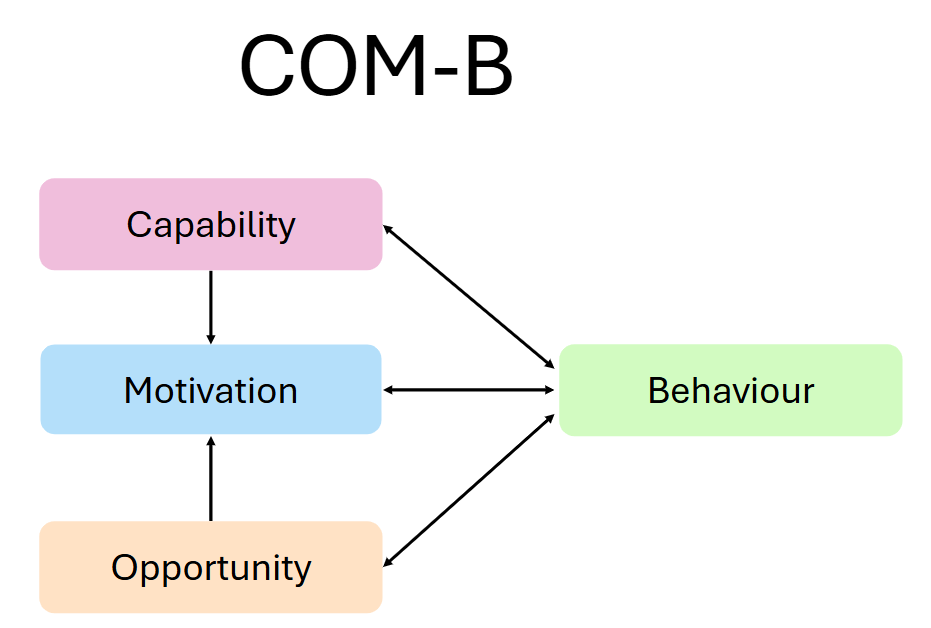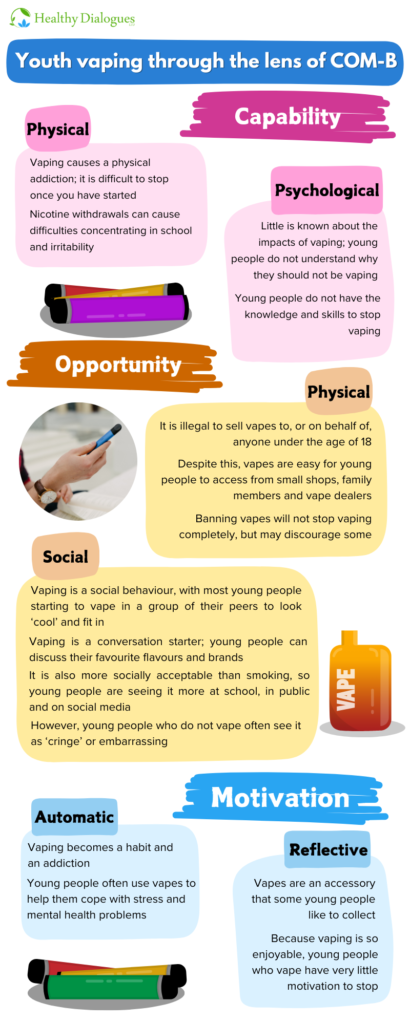In the field of behaviour change, there are many theories that we use to understand why making changes to improve our health and wellbeing is so difficult.
Perhaps the most widely accepted of these is the COM-B model by Michie, van Stralen and West (2011)[1], which outlines how our capability, opportunity and motivation influence our behaviour (figure 1).
Figure 1. The COM-B model

Capability
Capability can be broken down into physical and psychological capability. Essentially, this is whether a person is physically or psychologically capable of carrying out a behaviour.
We consider here if they have the necessary knowledge, skills, mental or physical strength or mental or physical stamina.
Opportunity
Opportunity is made up of physical and social opportunity. Physical opportunity is whether the person has the time, resources, materials or money to do something.
Social opportunity is whether it is a part of their social or cultural norms, it aligns with their values and if they have social support.
Motivation
Motivation is made up of automatic motivation and reflective motivation. Automatic motivation is someone’s habits, impulses and urges, and is often guided by their emotions and addictions (e.g., reaching for a packet of cigarettes as soon as you become stressed).
Reflective motivation, which is the conscious decision making someone does, is guided by our wants, our beliefs and our plans (e.g., I want to cut down on my smoking because I think it would be better for my health and help me to save some money).
So how do we use this model to inform behaviour change interventions?
Through gathering insights from an individual, a group or a population about the behaviour, we can identify key areas within the COM-B model where they may need support.
For example:
- If a lack of knowledge is acting as a barrier to change, an educational intervention would be beneficial.
- If someone lacks the social support from their friends and family to make a change, a support group may be appropriate.
While this model is a useful framework to guide us, it is important that we always work collaboratively and take people’s preferences and goals into account when planning interventions.
Applying this in the real world: youth vaping
To demonstrate how this process can work in a real-life intervention, we have outlined how we used the COM-B model to understand and inform interventions to discourage youth vaping.
Vaping is considered less harmful than smoking, but it is generally accepted than it is unlikely to be risk-free. Vaping is a relatively new concept, and more evidence is needed to understand what the long-term consequences may be. Although, short term impacts include headaches, shortness of breath and throat irritation.[2]
Vapes are useful tools for helping people to stop smoking, but they are not recommended for those who do not smoke. Vapes are also not recommended for children and young people under the age of 18. Because of this, it is against the law to sell vapes to anyone under the age of 18.
However, vaping is growing increasingly popular among young people in the UK. A survey by Action on Smoking and Health (ASH) [3] has shown that just over a fifth (21%) of children aged 11-17 had tried vaping in 2023, although this appears to have fallen to 17% in 2024.
Between May 2023 and May 2024, Healthy Dialogues carried out extensive research with young people to understand why they are vaping, what can prevent them from vaping and what support they need to stop once they have started, engaging with over 800 young people in the UK through focus groups and surveys on behalf of the Public Health teams in Bracknell Forest, Royal Borough of Windsor and Maidenhead and Merton.
We mapped our findings to the COM-B model, which is outlined in figure 2.
Figure 2: Youth vaping mapped to the COM-B model

From this and through examining the evidence-base, we developed and piloted several interventions to discourage youth vaping on behalf of the Public Health team in Merton.
These include an educational workshop, resource packs and a social media campaign, which you can find here.
The aims of these interventions were to provide young people with knowledge of the risks of vaping, have the social skills and confidence to say no to vaping and to learn how to stop vaping and cope with stress.
Additionally, resource packs for parents and professionals working with young people aimed to give them the knowledge and skills to talk to young people about vaping.
To find out more about these projects, you can read our case studies here.
[1] Michie, S., Van Stralen, M. M., & West, R. (2011). The behaviour change wheel: a new method for characterising and designing behaviour change interventions. https://link.springer.com/article/10.1186/1748-5908-6-42
[2] NHS (n.d.). Vaping to quit smoking. https://www.nhs.uk/better-health/quit-smoking/vaping-to-quit-smoking/
[3] ASH (2024). New figures show youth vaping has plateaued while adult vaping is at an all-time high. https://ash.org.uk/media-centre/news/press-releases/new-figures-show-youth-vaping-has-plateaued-while-adult-vaping-is-at-an-all-time-high
